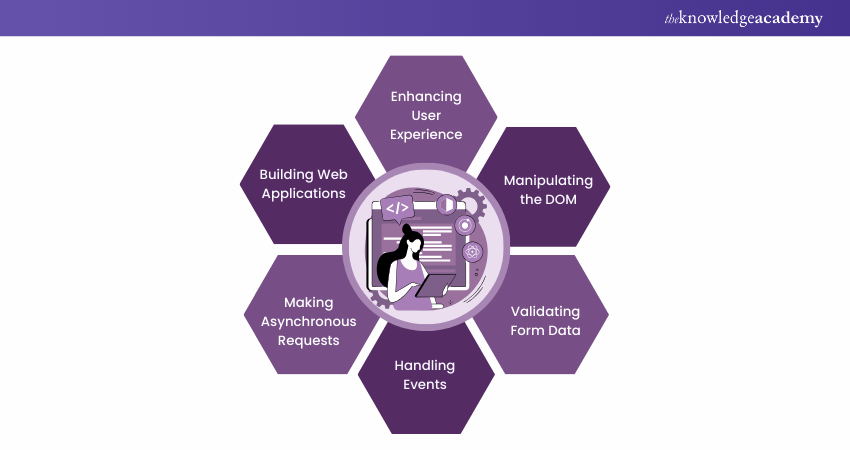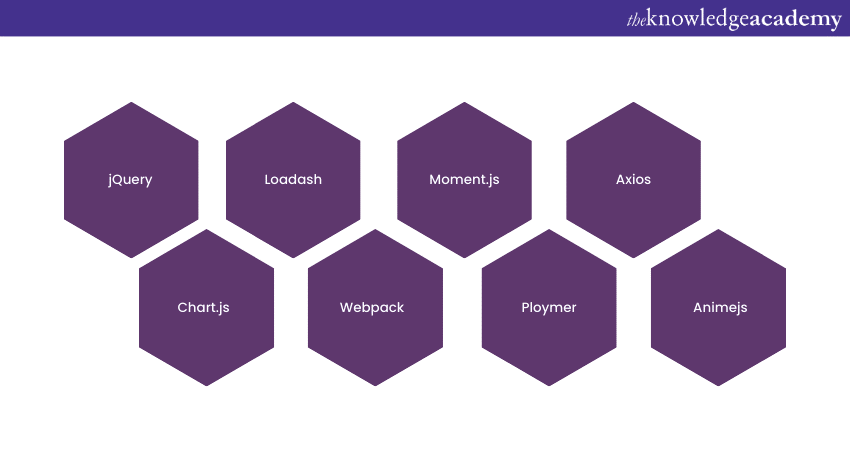We may not have the course you’re looking for. If you enquire or give us a call on +44 1344 203 999 and speak to our training experts, we may still be able to help with your training requirements.
We ensure quality, budget-alignment, and timely delivery by our expert instructors.

Are you new to the field of Web Development and Programming? If yes, you might have heard people tossing the term JavaScript around. But do you know What is JavaScript?
It is often called the “language of the web” and has become a powerful scripting language. According to Statista, more than 65% of Web Developers worldwide use JavaScript as their primary programming language.
So, familiarising yourself with this language is crucial if you wish to take a step ahead in your Web Development career. Read this blog to find out more about What is JavaScript and its components. Also, explore its significance in creating dynamic and interactive websites.
Table of Contents
1) Introduction to JavaScript
2) Purpose and Use of JavaScript
3) Applications of JavaScript
4) What are JavaScript frameworks?
5) JavaScript Libraries
6) Advantages and disadvantages of JavaScript
7) Conclusion
Introduction to JavaScript
JavaScript was made by Brendan Eich in 1995 at Netscape Communications to make web pages more interactive and engaging. Initially called “Mocha” and later “LiveScript,” it was eventually renamed “JavaScript” to capitalise on Java’s growing popularity. Since then, JavaScript has evolved significantly and is now supported by all major web browsers. It lets developers create dynamic features like image sliders, form validations, interactive maps, and real-time updates without requiring page refreshes.
At its core, JavaScript is a client-side scripting language that focuses on the behaviour and functionality of web pages. Unlike HTML and CSS, which handle structure and design, JavaScript enables developers to interact with web page elements, respond to user actions, and dynamically modify content. With JavaScript, developers can build interactive elements, validate form data, manipulate the Document Object Model (DOM), handle events, make asynchronous server requests, and much more, facilitating seamless interaction and real-time updates.
Purpose and Use of JavaScript
JavaScript is a versatile programming language that serves a vital purpose in Web Development. Its primary use is to add interactivity and functionality to websites, making them more dynamic and engaging for users. Let’s explore the purpose and various uses of JavaScript in the digital landscape:

Enhancing User Experience (UX)
By incorporating JavaScript into web pages, developers can create interactive elements that respond to user actions in real time. Whether validating form data, creating interactive menus, or implementing image sliders, the script enables developers to provide users with a more engaging and interactive experience.
Manipulating the DOM
JavaScript plays a crucial role in manipulating the DOM of a web page. The Document Object Model represents the structure of an HTML document as a tree-like structure. It provides powerful Application Programming Interfaces (APIs) that allow developers to access and modify elements in the DOM, enabling dynamic updates and changes to the content displayed on the web page.
As a result, developers can dynamically add or remove elements, modify text or styling, and respond to user events such as clicks or keystrokes. This capability allows seamless interaction between users and the web page, creating a more immersive and responsive experience.
Validating Form Data
It also allows developers to validate user input on the client side before sending data to the server. As a result, developers can ensure that users provide correct and valid data, such as required fields, proper email formats, or password strength. Moreover, this real-time validation helps prevent errors and enhances the overall user experience (UX) by providing immediate feedback to users.
Handling Events
JavaScript enables developers to handle events triggered by user actions or other sources. Event handling allows web pages to respond to user interactions, such as clicks, mouse movements, or keyboard input. Using JavaScript, developers can specify how the web page should react to these events, leading to a more interactive and dynamic user experience (UX).
Making Asynchronous Requests
JavaScript also facilitates making asynchronous requests to servers using techniques like Asynchronous JavaScript and XML (AJAX) or the newer Fetch Application Programming Interface (API). This allows web pages to retrieve data from servers in the background without requiring a full-page refresh.
Furthermore, asynchronous programming in JavaScript enables the creation of web applications that can update content dynamically, fetch data from APIs, and provide real-time updates to users.
Building Web Applications
With the rise of single-page applications (SPAs), where the content is dynamically loaded and updated without page reloads JavaScript has become even more essential. Frameworks and libraries like React, Angular, and Vue.js provide the tools and abstractions needed to create complex web applications with JavaScript at their core.
Transform your career with our Java Training – register today and become a sought-after Java Developer in no time!
Applications of JavaScript
Beyond Web Development, JavaScript has found applications in various fields, showcasing its flexibility and power. Let’s talk about them:
a) Web and Mobile Apps: JavaScript frameworks like jQuery and ReactJS enhance design efficiency by allowing code reuse and updates without conflicts. Mobile frameworks such as Cordova and Titanium enable the creation of native or hybrid apps. Node.js, with its single-threaded, non-blocking architecture, reduces server response time and supports scalable microservices. Additionally, combining Nodejs Typescript enhances development efficiency and provides better type safety for large-scale applications.
b) Building Web Servers and Server Applications: Node.js simplifies the creation of web servers and back-end infrastructure. Its built-in Hypertext Transfer Protocol (HTTP) module allows for the development of basic HTTP servers. Node-OS is optimised for Linux, and third-party servers like Internet Information services (IIS) and Apache can handle HTTP requests efficiently.
c) Interactive Behaviour on Websites: JavaScript adds dynamic elements to web pages, such as animations and dropdown menus, enhancing user interaction. It supports various data types and allows Hypertext Markup Language (HTML) content changes without page reloads. JavaScript also manages cookies for a better browsing experience and can be used to Stop Pop-ups on Android devices.
d) Game Development: JavaScript, combined with HTML5 and APIs like WebGL, facilitates game development. Engines like Phaser, GDevelop, and Kiwi.js support graphics rendering, code reuse, and cross-platform applications. Notable games developed with these engines include Angry Birds, The Wizard, and 2048.
What are JavaScript Frameworks?
JavaScript frameworks are pre-written collections of code and libraries that provide developers with a set of tools, abstractions, and patterns to simplify the process of building web applications. They aim to streamline development, increase productivity, and maintain code organisation and consistency.
Numerous JavaScript frameworks are available, each with its own strengths and application areas. Here are some popular frameworks:
a) React: React, developed by Facebook, is a component-based framework for building user interfaces (UI). It focuses on creating reusable UI components and offers efficient rendering techniques, making it suitable for large-scale applications.
b) Angular: Angular, developed by Google, is a comprehensive framework for building complex web applications. It provides a full-featured ecosystem, including components, routing, state management, and dependency injection.
c) Vue.js: Vue.js is a lightweight framework that emphasises simplicity and ease of use. It offers a flexible and intuitive API, making it a popular choice for both small-scale and large-scale applications.
d) Ember.js: It is a framework that follows a convention-over-configuration approach. It provides a structured architecture and strong opinions, making it ideal for large-scale applications with complex requirements.
e) Backbone.js: Backbone.js is a lightweight framework that focuses on providing structure to JavaScript applications. It offers models, views, and collections, allowing developers to build scalable and organised applications.
JavaScript Libraries
JavaScript libraries are reusable code modules encapsulating specific functionalities, such as DOM manipulation, AJAX requests, data handling, animations, and more. They are designed to be easily integrated into web projects, allowing developers to leverage existing code and save time and effort.
Unlike frameworks that provide a comprehensive structure and architecture for web application building, libraries focus on specific tasks or functionalities. They offer a set of functions, classes, and methods developers can use to perform common operations without reinventing the wheel. A JavaScript Cheat Sheet can be a valuable resource for developers to quickly reference key functions and methods. Here are some popular JavaScript libraries:

a) jQuery: jQuery is a fast and lightweight library that simplifies HTML document traversal, event handling, animation, and AJAX interactions. It provides an easy-to-use API, making it popular for adding interactivity to web pages.
b) Lodash: Lodash is a utility library that provides a set of helper functions for common programming tasks. It offers functions for array manipulation, object manipulation, string manipulation, functional programming, and more. Lodash enhances code readability and simplifies complex operations.
c) Moment.js: Moment.js is a JavaScript library for working with dates and times. It provides comprehensive date parsing, formatting, manipulation, and display functionalities. Moment.js simplifies complex date-related operations and enables consistent handling of dates and times.
d) Axios: It is a popular library for making HTTP requests from JavaScript applications. It provides an intuitive API for performing AJAX requests and handling responses. Axios supports features like request cancellation, interceptors, and automatic JSON parsing.
e) Chart.js: Chart.js is a versatile library for creating interactive and responsive charts and graphs. It supports various chart types, including line, bar, pie, and more. Chart.js simplifies the process of visualising data and makes it easier to create dynamic and engaging visual representations.
Create stunning graphical user interfaces with our Java Swing Development Training – book your spot now!
Advantages and Disadvantages of JavaScript
After you have read What is JavaScript. It's time to learn about its advantages and disadvantages. Like any technology, JavaScript has its benefits and limitations, so let’s explore some of them:
Advantages of JavaScript
The following are the advantages of JavaScript:
JavaScript offers numerous advantages that make it a preferred choice over its competitors. Here are some key benefits of using JavaScript:
1) Simplicity: JavaScript’s straightforward structure makes it easy to learn and implement. It also runs faster than some other languages, with errors being easy to choose and rectify.
2) Speed: JavaScript runs scripts directly within the web browser, eliminating the need to connect to a server or use a compiler. In addition, most major browsers allow JavaScript to compile code while the program is running.
3) Versatility: JavaScript is compatible with other languages, including PHP, Perl, and Java. It also facilitates data science and machine learning for developers.
4) Popularity: There are plenty of resources and forums available to assist beginners with limited technical skills and knowledge of JavaScript.
5) Server Load: Operating on the client side, JavaScript lessens the number of requests sent to the server. Data validation can be performed via the web browser, and updates apply only to specific sections of a web page.
6) Updates: The JavaScript development team and the European Computer Manufacturers Association (ECMA) continuously update and create new frameworks and libraries, ensuring their ongoing relevance in the industry.
Take your career to the next level with our Java Programming Course - sign up today and future-proof your career!
Disadvantages of JavaScript
The following are the disadvantages of JavaScript:
a) Security Vulnerabilities: JavaScript runs on the client side, exposing it to potential security risks. It is essential to implement security measures and follow best practices to mitigate vulnerabilities such as Cross-site Scripting (XSS) attacks and code injection.
b) Browser Support Limitations: While JavaScript is widely supported, there may be variations in browser implementations and support for certain features. Developers need to account for these differences and perform thorough testing to ensure cross-browser compatibility. Understanding Java vs JavaScript can also help clarify their distinct roles, as Java is a standalone programming language, whereas JavaScript is primarily used for web development.
c) Performance Limitations: Complex JavaScript operations or inefficient code can lead to performance bottlenecks, especially on older devices or slower browsers. Careful optimisation is required to maintain smooth performance.
d) Lack of Robust Typing: avaScript is a dynamically typed language, meaning variable types can change during runtime. This flexibility can sometimes lead to unexpected bugs or errors that a more rigid type system could have caught. However, TypeScript, a typed superset of JavaScript, can be used to address this concern.
e) Dependency on Client-side Execution: As JavaScript runs on the client side, it requires the user’s browser to support and execute the code. This dependency on client-side execution means that users with disabled JavaScript or older browsers may not be able to access or interact with JavaScript-powered features fully.
Conclusion
With its ability to enhance user experiences (UX), cross-browser compatibility, and vast ecosystem of libraries and frameworks, JavaScript has become a cornerstone of the digital landscape. Therefore, understanding What is JavaScript and staying abreast of its best practices and advancements is key to leveraging its full potential.
Don’t get left behind in the fast-paced tech industry – join our Java Engineer Training and acquire cutting-edge knowledge and practical skills!
Frequently Asked Questions
What are the Best Practices for Implementing Javascript?

Implement JavaScript best practices such as modularisation, using meaningful variable names, avoiding global variables, and leveraging asynchronous programming with promises or async/await. Ensure code readability, maintainability, and performance optimisation through regular testing and code reviews.
What is the Distinction Between Java and JavaScript?

Java is a programming language that uses static typing to build enterprise-level applications, whereas JavaScript is a scripting language with dynamic typing, mainly utilised for front-end Web Development. Java works on the Java Virtual Machine (JVM), while JavaScript runs in web browsers.
What are the Other Resources and Offers Provided by The Knowledge Academy?

The Knowledge Academy takes global learning to new heights, offering over 3,000 online courses across 490+ locations in 190+ countries. This expansive reach ensures accessibility and convenience for learners worldwide.
Alongside our diverse Online Course Catalogue, encompassing 19 major categories, we go the extra mile by providing a plethora of free educational Online Resources like News updates, Blogs, videos, webinars, and interview questions. Tailoring learning experiences further, professionals can maximise value with customisable Course Bundles of TKA.
What is The Knowledge Pass, and How Does it Work?

The Knowledge Academy’s Knowledge Pass, a prepaid voucher, adds another layer of flexibility, allowing course bookings over a 12-month period. Join us on a journey where education knows no bounds.
What are the Related Courses and Blogs Provided by The Knowledge Academy?

The Knowledge Academy offers various Java Courses, including the JavaScript for Beginners Course, Java Swing Development Training, and Java Engineer Training. These courses cater to different skill levels, providing comprehensive insights into Django Alternatives.
Our Programming & DevOps Blogs cover a range of topics related to JavaScript, offering valuable resources, best practices, and industry insights. Whether you are a beginner or looking to advance your Programming and DevOps skills, The Knowledge Academy's diverse courses and informative blogs have got you covered.
Upcoming Programming & DevOps Resources Batches & Dates
Date
 JavaScript for Beginners
JavaScript for Beginners
Fri 7th Mar 2025
Fri 23rd May 2025
Fri 18th Jul 2025
Fri 12th Sep 2025
Fri 12th Dec 2025






 Top Rated Course
Top Rated Course



 If you wish to make any changes to your course, please
If you wish to make any changes to your course, please


